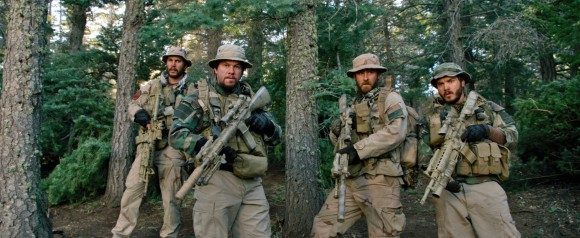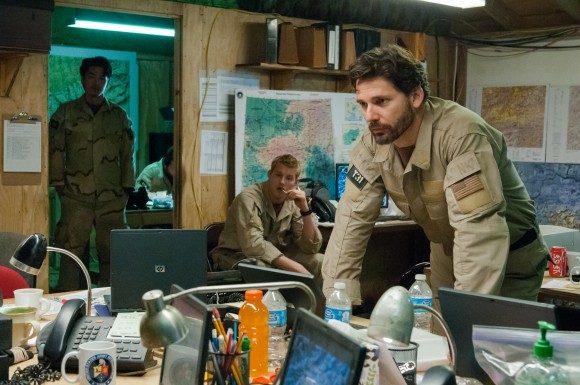Perhaps like me you saw this trailer for Lone Survivor, and perhaps like me you thought it looked like a pretty lousy execution on a potentially excellent premise. I’m happy to report that for the most part these fears go unfounded. Lone Survivor still isn’t the second coming of Zero Dark Thirty that at times it seems to wish it was, but it’s a quality movie that celebrates the bravery and fortitude of the Navy SEALs and the camaraderie of military servicemen without devolving into sensationalism or becoming an unthinking shoot-em-up.
The story is drawn from the real-life Operation Red Wings, a joint military operation which took place in Afghanistan in 2005. Four Navy SEALs (played by Mark Wahlberg, Taylor Kitsch, Emile Hirsch, and Ben Foster) are inserted on a reconnaissance mission to verify the location of a Taliban leader for a follow up attack, but subsequently find themselves outnumbered and under heavy fire when they’re stumbled upon by goat herders who swiftly alert the Taliban to their presence, and they can’t be extracted because their radio isn’t working. The story is actually very structurally reminiscent of Captain Phillips by way of Gravity. There’s a brief setup that takes care of establishing the main SEAL team, plus a couple key supporting SEALs played by Eric Bana and Alexander Ludwig, but the main part of the movie begins with the onset of disaster. At least half of the movie’s two hour runtime is one extended action scene where the SEAL team is engaged in combat with Taliban militants.
Since I’ve invoked Paul Greengrass’s Captain Phillips as a point of reference, it’s worth noting a couple of key distinctions. Whereas in both Captain Phillips and his more controversial Flight 93 Greengrass takes steps to build sympathy for his antagonists as fellow human beings despite their reproachable actions, director Peter Berg (Hancock, Friday Night Lights) wants to make it very clear: Taliban equal bad guys. There’s a scene early on where the Taliban militants brutally execute a villager they’ve suspected of helping the Americans that unflinchingly seeks to drive home the point that the audience should get on board with taking these guys out. I’m not faulting him for the choice, and there’s little argument to be made in favor of such a violent and oppressive regime, but part of the reason I mentioned Gravity as well is that the Taliban comes across much more as a force which the protagonists vie against, not unlike deadly space debris, than anything recognizably human, and it seems to be a very intentional move.
Thankfully this whitewashing does not extend to the protagonists or, perhaps especially, to all Afghanis. On the latter point, suffice it to say that there is some appreciated nuance, even if it’s seen through America goggles. As mentioned, we do get some characterization on several of the SEALs early in the movie, and in stark contrast to the Taliban, this does a lot to fix them in the audience’s mind as real people. This is a story about action, not character arcs, but it’s important that we care about the figures in the drama, even some of the supporting cast outside of the main SEAL team. There’s an enormously powerful moment about two thirds of the way through the movie, for example, that for spoiler reasons I won’t go into in detail, but its impact is entirely a function of knowing some of the people involved on what feels like a personal level. The only place characterization is strained is when some very artificial feeling interpersonal stress is added between the characters played by Foster and Wahlberg. This also is played up in the marketing, where it appears Foster’s character is going lone wolf to the exclusion of his SEAL teammates, but this simply isn’t the case. They have a disagreement that feels real enough, but there’s too much made of a need for reconciliation. I never believed it was that divisive an issue, particularly in the context of them actively taking fire from Taliban militants.
But again, most of this movie is action, so what about it? Lone Survivor goes for an unembellished aesthetic to highlight the near-superhuman feats of its subjects. By and large it’s successful, but there are a couple of pieces that felt off, particularly in the way the action is captured. There was a video game-ish quality to much of the camerawork that, given the subject matter, felt very out of place. This wasn’t a commentary (I don’t think) on the game industry’s love for military shooters, either; instead, it contrasted oddly to the very realistic depiction the movie was going for. Similarly, there are a couple times where the SEALs are forced to take Butch and Sundance-style leaps down the side of a mountain that put heavy strain on believability. These are steep, rocky mountainsides, and the SEAL team is quite literally tumbling head over heels, smacking into trees and outcroppings as they go. Makeup does a good job of showing the abuse they’re taking on a superficial level, but at some point it’s hard to believe even these guys are physically capable of getting up and running after all the internal trauma their bodies have sustained.
The Verdict: 3 out of 5
Based on the marketing, I expected this movie to trip over itself in an effort to be pro ‘Murica despite the tragedy ensured by the title. And yes, it is a tribute to American military efforts, particularly the extraordinary capacities of the best the military has to offer: the Navy SEALs. But even though this is an action movie that paints its enemy in an inhuman light, there’s sufficient character and nuance here that it’s still an easy film to get behind, particularly in light of some conscious efforts to differentiate the people of Afghanistan at large from the evil of the Taliban. Lone Survivor is a straightforward story, but one that’s competently executed and will certainly appeal to a particular cross section of the moviegoing audience.




